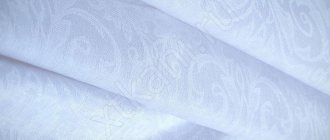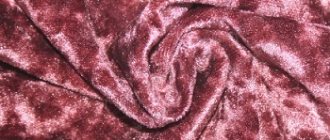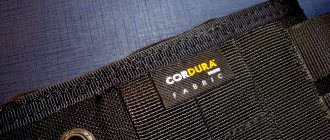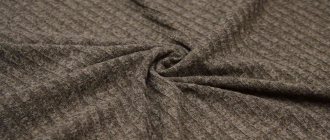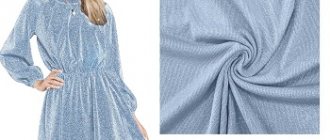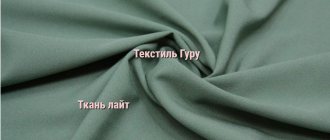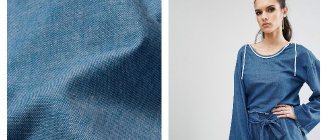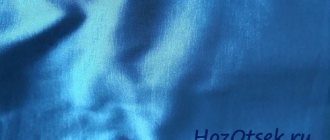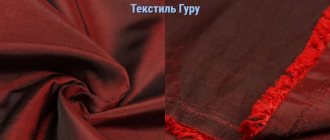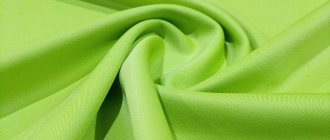Just a couple of decades ago, when mentioning jacquard fabric, the average person would associate it with a jacquard bedspread or expensive curtains. Now there are so many types of jacquard that one can doubt what jacquard fabric really is? Let's figure it out.
Jacquard first appeared in France, thanks to the inventor Joseph Jacquard, in 1801. He invented a special loom on which it was possible to produce fabric with a large, complex color pattern. Since then, the material has been produced on an industrial scale. Punch cards were already used in the machine back then!
Description
Jacquard is a special way of weaving threads to obtain a complex, double-sided pattern, similar to an ornament. A sample of the fabric is a tapestry with three-dimensional, multi-colored patterns.
To obtain jacquard fabric, threads of various compositions, both natural and artificial, are used. In different combinations they form mixed fabrics. The most valuable material is made of silk or cotton. Synthetic jacquard fabrics are considered the most common and popular. The density of the material depends on the thickness of the threads included in it and the density of the weaving. Making jacquard fabric is a complex and labor-intensive process. To create a composition, sometimes over 100 multi-colored threads are required.
Interesting! The material is named after the inventor of the loom, Joseph Jacquard, which produced fabric with patterns of different sizes from colored threads. This event happened in France at the beginning of the 19th century.
Weaving technology has been preserved since its creator. But the weaving machines have changed, become more productive and are now controlled by software.
The characteristic of jacquard is its strength, which is imparted by twisted threads. Bright colors applied using reactive dyeing technology retain their saturation for a long time. Matter is not inclined to stretch. The material is abrasion resistant and durable.
Exquisite jacquard patterns always remain in fashion. They retain their shape and appearance.
Color
Color design is obtained in two ways:
- Printed, when a design is applied to the finished material.
- The fabric is woven from pre-dyed threads, which may differ in composition and density.
Jacquard fabric is produced in single-color and multi-color. The most common option is a canvas in two tones, where one fills the background and the second a pattern. If a plain jacquard looks laconic, then the colored fabric is immediately transformed.
Types in application
Information about the options for use and varieties will help you understand what kind of jacquard fabric it is. Luxurious appearance combined with density and wear resistance ensured the fabric's popularity and scope of application.
Natural materials made of cotton, linen or silk are intended for bed linen. Fabrics common in the textile market with the addition of viscose, polyester, polypropylene or completely synthetic are elastic and easy to care for. Used for making elegant dresses, bedspreads, curtains.
Advantages and disadvantages
Jacquard fabric has only one drawback - high cost. At the same time, fabric made from natural fibers is more expensive than synthetic ones.
Jacquard knitwear
Advantages:
- increased strength;
- high wear resistance;
- resistance to temperature changes;
- ease of care.
Furniture
Jacquard is used for upholstery of upholstered furniture and sewing covers. The material has increased density and rigidity. The durable structure protects against snags and abrasion.
Fabrics can be silky, with pile and combined. These are mainly mixed fibers. The design is obtained by weaving and printing. Expensive silk fabrics are decorated with gold or silver thread.
Velours
Thick velor with a velvety surface and intricate patterns is considered the best upholstery for furniture. It has aesthetic properties and practicality. Used for products of complex shapes and ceremonial purposes.
Tapestry
Antique, thick fabric with a plot composition, artistic design or complex ornament. It is obtained by interlacing a large number of thick threads of different colors.
Jacquard chenille
A beautiful and durable material, the surface of which combines a smooth base and a matte, fluffy pattern. It is made in a single color with a textured pattern formed by the interweaving of thin and dense threads. And also multi-colored, where threads of different textures and colors are twisted. The material is pleasant to the touch and is not subject to contamination.
Thermo-Jacquard
The fabric is the result of the development of textile technologies, when a design is applied to the base using thermal printing (sublimation printing). The upholstery material is additionally treated with impregnation, which envelops the fibers with a thin film.
Soft jacquard
The fabric has a short, soft pile like velvet and is decorated with a voluminous pattern. These can be floral and abstract patterns, prints. Produced in a variety of colors.
Costume and dress
Textured and noble fabric has found application in sewing dresses, skirts, suits, trousers for festive occasions and special occasions. Men wear ties made of jacquard fabric with pleasure on weekdays and holidays. Light summer coats and jackets have remained at the peak of fashion for several seasons.
Satin jacquard
Initially, silk threads gave shine to the material, but gradually they were replaced by artificial fibers. The beautiful fabric is light and wrinkle-resistant, with a smooth, glossy surface. Multi-colored shine makes jacquard satin elegant.
The material is intended for sewing curtains and bedspreads, and interior decoration. It has a characteristic shine and an aristocratic appearance, which gives the products solemnity. During production, synthetic and elastic fibers are woven into satin jacquard to improve performance properties.
Jacquard knitwear
Jacquard knitwear is intended for warm clothes. Popular: sweaters, cardigans, dresses, hats, scarves and mittens. The use of thick threads gives relief. It can be natural or mixed. The variety of bright, multi-colored knitwear patterns makes such products exclusive.
Jacquard-silk
Lightweight, soft and airy fabric with a great look. Made from natural and synthetic fibers. Effectively shimmers depending on the lighting. Used to create designer outfits, when sewing luxury underwear and bedding.
Suit
Suit jacquard is used for warm and light clothing that will look great in any cut. The pattern is voluminous, rich and restrained, monochromatic. A contrasting combination of colors is often used to highlight the pattern. Such fabrics are laid out in folds and draperies.
Jacquard stretch
It is a large-patterned fabric of medium density. Stretch threads of lycra, elastane or spandex give the jacquard elasticity. Thanks to this, it stretches well and fits the figure.
Reviews
I was given a jacquard satin bedspread as a housewarming gift. Contains cotton and synthetic. I'm very pleased with it! In five years, the appearance has remained virtually unchanged. What’s unique is that the bedspread does not wrinkle: you pull it off the bed at night, sometimes you crumple it at random, and in the morning, you make the bed, and the bedspread is not wrinkled at all! I haven’t ironed it even once, even after washing it! I recommend this material to everyone.
Natalia
I have jacquard curtains. I only wanted these! Dense, do not allow light to pass through. Easy to care for: I wash it in the machine, though, with water 30 degrees, I don’t risk getting too hot (I don’t think it’s necessary, the dust is washed off anyway, and I don’t have any special stains on the curtains). After washing they dry quickly, I ironed them lightly and hung them up again.
Oksana
I work in furniture production, directly upholstering upholstered furniture. Will collide with jacquard. It is easy to work with and the furniture looks beautiful. I couldn’t resist and bought myself a sofa for the kitchen. This is the second year that I am happy: the fabric holds its shape, there are no snags or stretch marks anywhere, it has not faded or frayed. Practical, unpretentious, easy to clean with a sponge and detergent. At first my friends looked wary and convinced me that it was more practical to use leatherette for the kitchen, but one friend’s leatherette cracked after two years, and my sofa was like new. Therefore, now they are also convinced that jacquard has many advantages.
Sergey
I liked the stretch dress in the store, the consultant said that the stretch was jacquard. It looked very impressive in the window: it shimmered, but at the same time it was restrained, stylish and rich! I asked to try it on and was disappointed: it fit perfectly, but stuck to every fold. I refused the dress and decided that it was only worn with an ideal figure and special shapewear.
Curtains
Jacquard fabric has also found application in the field of interior decoration. Curtains, tulle for windows, and bedspreads are made from it. They transform the room and are suitable for any style.
Brocade jacquard
This heavy, silky fabric is covered with an intricate pattern woven with gold or silver thread. The pattern can also be formed by alternating dark and light threads, glossy and matte areas. The canvas has royal luxury. It looks impressive and solemn. Made from silk, viscose or synthetic fibers. Used for sewing curtains, bedspreads, decorative items and theatrical costumes.
Organza
Thin and airy organza is also made with a jacquard pattern. The embossed pattern adds splendor and elegance to the fabric. The material is most often used for sewing curtains, elegant fluffy dresses, and when arranging bouquets and gifts.
How to choose
First of all, consumers choose jacquard according to its intended purpose. The criteria of price and brand are not of great importance and depend on the personal preferences of the buyer, as well as financial capabilities.
The range of materials, the distinctive feature of which is a relief pattern, is truly huge. Jacquard is used to make bedspreads, covers, canopies, bags, ties and other items of clothing, and curtains. The appearance of sofas covered with such material is distinguished by its beauty and at the same time such upholstery is very practical. Jacquard table linen (tablecloths, napkins) looks very rich and solemn, and how high quality it will be depends on the composition of the fabric.
Advice! How much jacquard material will cost is determined by its composition: the more fibers of natural origin it contains, the more expensive the fabric. The price per meter also depends on the manufacturer.
Currently, the Russian market is filled with jacquard from Chinese manufacturers, which is distinguished by its low cost, while the quality can be very acceptable. Chinese-made jacquard is most often represented by synthetic or mixed material.
Jacquard fabric with patterns
Sometimes there are paintings of joint production. For example, a serious Italian company with a good reputation produces jacquard in China. We can say that such cooperation provides a low price (lower than for Italian products) with very good quality.
Turkish jacquard is considered better than Chinese jacquard, since it contains more raw materials of natural origin, and the products are of higher quality.
They are distinguished by the highest quality fabric from European manufacturers, but at the same time they are very expensive. This fabric contains the best raw materials, for example, manufacturers from Portugal add the best Egyptian cotton to jacquard.
Domestic jacquard is of relatively high quality and inexpensive, produced in Ivanovo.
Bed sheets
Cotton jacquard is used for luxury bedding sets and table textiles. It is comfortable, pleasant to the body, looks great from the front and back.
It doesn't wrinkle and is quite dense.
Jacquard-satin
Delicate fabric with a silky surface made of natural cotton threads. A distinctive feature of satin jacquard is its double-sided pattern, in which one side is embossed and the other is pressed. The pattern alternates between the colors of the ornament and the background.
Ranfors
Soft, thin and smooth material with a dense structure. It is distinguished by its hygienic properties, ease of use and durability. Ranfors is produced with an abstract or floral pattern in a two-color design.
Composition and properties
The main properties of all jacquard fabrics:
- durable due to complex weaving and twisting of threads;
- quite light, despite the density;
- wear-resistant, tolerates washing well;
- retain color brightness for a long time;
- do not stretch and keep their shape well;
- pleasant to the touch;
- look luxurious.
Silk jacquard
Some properties of jacquard depend on the raw materials:
- Natural fibers - wool, cotton, linen, silk. These are hypoallergenic materials that are pleasant to the body.
- Synthetic jacquard is woven from polyester and polypropylene. It is cheaper than natural fabric, but is also quite durable and wear-resistant. However, it is stuffy and poorly suited for clothing, but excellent as upholstery, tablecloth, etc. textiles
- The mixed option is optimal in terms of price and quality ratio.
Care
Jacquard fabrics are beautiful and do not need special attention. Simple rules of care will help you maintain a luxurious look longer.
- For washing, use warm water no higher than 30 °C.
- Machine wash cycle – delicate.
- Textiles do not require special detergents.
- When removing stains and dirt, avoid strong friction to avoid damaging the structure.
- Leave to drain.
Important! Jacquard does not like machine spinning and twisting.
- Dry away from sunlight so as not to spoil the design.
- Iron from the wrong side, and set the heating mode depending on the composition.
The surface of upholstered furniture needs careful dry cleaning with a brush or vacuum cleaner. To remove minor stains, you will need a sponge and a soap solution made from a mild detergent and warm water.

